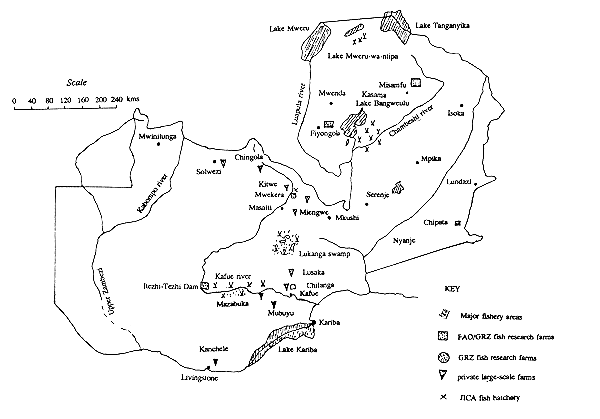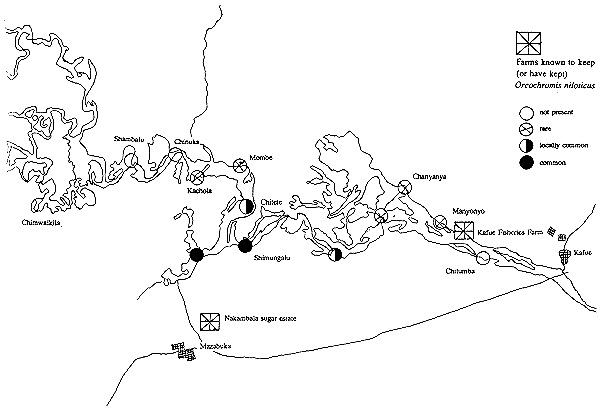CONSULTANCY ON AQUACULTURE SPECIES INTRODUCTIONS, ZAMBIA
Review previous introduction of aquatic organisms in Zambia;
Confirm the FAO data on introduction and native species within Zambia;
Review the compliance with established guidelines (EIFAC/ICES) on introduction of aquatic animals;
Interview selected officers, farmers and interested organizations of desired species for introduction, and on legal and logistic policies on introduction;
Review any existing lists of species intended for introduction collected in the interviews mentioned above: these reviews should include data on locations where specific species have been introduced and a description of the effects of the introduction; the reviews will also discuss the aquaculture potential (including advantages and disadvantages of species intended for introduction);
Recommend a plan of action which may include hiring other specialists, development of small projects, development of FAO Technical Cooperation Projects, or other activities as deemed necessary.
Timing: 10 September - 3 October 1992
Mission Members:
Prof. Dirk F. Thys van den Audenaerde, Consultant, ALCOM
Mr Charles Maguswi, Chief Fisheries Officer, Department of Fisheries, Zambia
Mr Boyd A. Haight, Senior Aquaculturist, ALCOM, Harare
Mr Andreas Jensen, Aquaculturist (APO), ALCOM, Mansa
| September 10: | Brussels - Rome |
| September 11: | FAO offices, Rome |
| September 12: | Rome - London |
| September 13: | London - Nairobi |
| September 14: | Arrival Nairobi; Nairobi - Lusaka Meeting with FAO & ALCOM officials |
| September 15: | Lusaka - Chilanga (Fisheries Department Headquarters, Fish Culture Research Station) Chilanga - Livingstone (Mr Grubb's crayfish farm) |
| September 16: | Livingstone - Mazabuka (Makambala Fish Farm), Mazabuka - Mubuya (Mubuya Fish Farm) Mubuya - Lusaka |
| September 17: | Lusaka - Chilanga - Lusaka - (AMI farm) - Kitwe |
| September 18: | Kitwe - (Nchanga Fish Farm, Mwekera Fish Culture station) |
| September 19: | Kitwe - Ndola (road) Ndola - Kasama (air) (Misamfu Fish Farm, NORAD fish culture project) |
| September 20: | Kasama - Mbala |
| September 21: | Mbala (Nchanga Farm) Nunzu Estate Fish Ponds, Lake Chila, Uningi Pans |
| September 22: | Mbala Uningi - Mpulungu - (Samaki Fisheries Ltd) - Mbala |
| September 23: | Mbala - Nakondo - Isoka (Department fish ponds) |
| September 24: | Isoka - Nyika plateau (Muyombe) - Isoka |
| September 25: | Isoka - Mbesuma (Chambezi Fisheries) - Kasama (Misamfu Fish Farm) |
| September 26: | Kasama - Lusaka (air) - Kafue Fish. Ltd (road) |
| September 27: | Kafue Fisheries Ltd |
| September 28: | Kafue - Chilanga (Fisheries Department, Library, Museum) - Lusaka (AMI-Fish Farm) |
| September 29: | Lusaka (UN and FAO offices) - Kariba |
| September 30: | Kariba (Lake Kariba Fisheries Research Institute; Freshnet Fish Farm; Kariba Bream Farm) - Harare |
| October 1: | Harare (ALCOM office) |
| October 2: | Harare (ALCOM office) Harare - (depart. 21h15) - Frankfurt |
| October 3: | Arrival Frankfurt; Frankfurt - Brussels |
| November 3: | Brussels - Rome (FAO offices) |
| November 4: | Rome (FAO offices) |
| November 5: | Rome - Brussels |
In Zambia
In Zimbabwe
Fisheries
Zambia has great potential for increasing fish production from her lakes, swamps and rivers. Significant increase in fish production from aquaculture/fish farming is also possible with improved extension methods. Increased fish production should result in improved incomes, better nutritional standards for the population and exports to earn foreign exchange. Over the past two decades, the performance of the fishing industry has been generally unsatisfactory. Although the total fish catch has increased from 47,000t of fish in 1971 to 66,000t in 1991, the per capita consumption of fish has decreased from 12kg to only 8kg. Production from fish farming increased from 692t in 1986 to 1,072t in 1988, and is currently estimated at 3,500t annually. This increase is too small compared to the potential production from fish farming in the country.
Major causes for the poor performance of the fishing industry include: inadequate knowledge of the sizes of fish resources in various water bodies, leading to overfishing in some places and under-exploitation of some fish stocks: inappropriate fishing technology; inadequate fishery management services; critical shortage of trained manpower, particularly in the area of fish stock assessment to devise appropriate fishery management strategies and to oversee fishery activities; inadequate communications infrastructure resulting in limited access to fishery areas; and poor policies for the sector.
Fishery policy should pay more attention to removing these and other constraints. The Ministry's high priority areas should therefore be as follows:-
Specialised manpower training, particularly in the area of fish stock assessment, so as to strengthen the capacity of the Department of Fisheries to plan the management of capture fisheries in a proper and rational manner.
Provide trained fisheries technicians to collect accurate data needed to plan development of the fishing industry and to effectively supervise fishery conservation programmes.
Regulate the fishing pressure exerted on any given fishery in such a manner that highest ecological productivity is attained and conserved.
Provide specialized manpower to supervise and plan the development of aquaculture in the country, including introduction of cage culture.
Increase the supply of trained aquaculture technicians at the village level to improve extension services to fish farmers.
Facilitate and encourage credit facilities to fishermen and fish farmers.
Improve the supply and availability of inputs to the fishing industry and equip the Department of Fisheries adequately so that it can perform its functions and fulfil its role.
Promote the exploitation of traditional fisheries, and encourage the harvesting of other aquatic organisms for economic purposes and introduction of territorial fishing rights.
Fishery management strategies and plans to be based on sound ecological principles. Emphasis to be placed on fisheries and aquacultural research so that adequate information/data to plan the development of the sector is generated.
Expansion of fish farming practices and techniques to commercial levels.
Encourage cooperation with other countries on matters related to management and development of fisheries of transboundary water bodies.

(based on observations by E. Schwenck)

REPUBLIC OF ZAMBIA
FISHERIES
CHAPTER 314 OF THE LAWS OF ZAMBIA
Bell-Cross G. 1976 - The Fishes of Rhodesia
Trust. Nat. Mus. & Monm. Rhodesia, Salisbury; 268p
Bell-Cross G. & Bell-Cross B. 1971 - Introductions of Limnothrissa miodon and Limnocaridina tanganicae from Lake Tanganyika into Lake Kariba. Fish. Res. Bull. Zambia, 5, p 207–214
De Bont A.F. 1950 - Rapport Annuel 1947–1948 de la Station de
Recherches Piscicoles.
Bull. Agr. Congo Belge, XLI, No 2, p 473–538
de Moor I.J. & Bruton M.N.. 1988 - Atlas of alien and
translocated indigenous aquatic animals in Southern Africa.
S. Afr. Nat. Sci. Progr. Rep. no10 – 144; 310p
FAO-ALCOM. 1992 - Aquaculture in Southern Africa : a Sketchbook, Harare; 60p
Jackson P.B.N. 1960 - On the desirability or otherwise of
introducing fishes to waters that are foreign to them
The 3rd Symposium on hydrobiology and inland fisheries problems of major lakes, Lusaka, Zambia
18–24 august 1960
C.S.A. Publ. no 63, p 157–164
Jubb R.A. 1967 - Freshwater Fishes of Southern Africa
Balkema, Cape Town; 248p
Mortimer M.A.E. 1960 - Hybrid tilapia in Northern Rhodesia
C.R. Symp. Lusaka, Publ. C.S.A., no 63, p 185–195
Thys van den Audenaerde D.E.F. 1968 - An annotated
Bibliography of Tilapia (Pisces, Cichlidae)
Publ. MRAC-Tervuren, Zool. Doc. no 14, 406p
Devos L, Snoeks J. & Thys van der Auderaerde, D. - 1990
The effects of tilapia introduction in Lake Luhondo, Rwanda
Ems Biol. Fish. , 27, p 303 – 308
Trewavas E. 1983 - Tilapiine Fishes of the genera
Sarotherotodon, Oreochromis and Danakilia
Brit. Mus. Nat. Hist., London, 583p
Welcomme R.L. 1981 - Register of International transfers of
inland fish species
FAO Fisheries Technical Paper no 213, 120p
